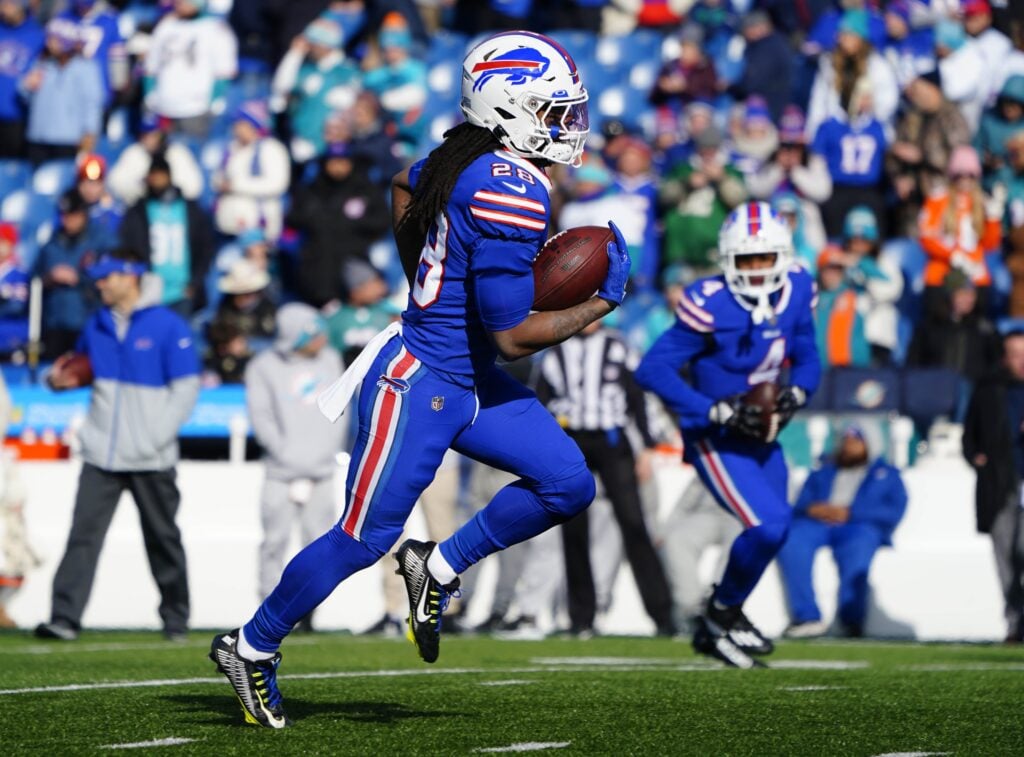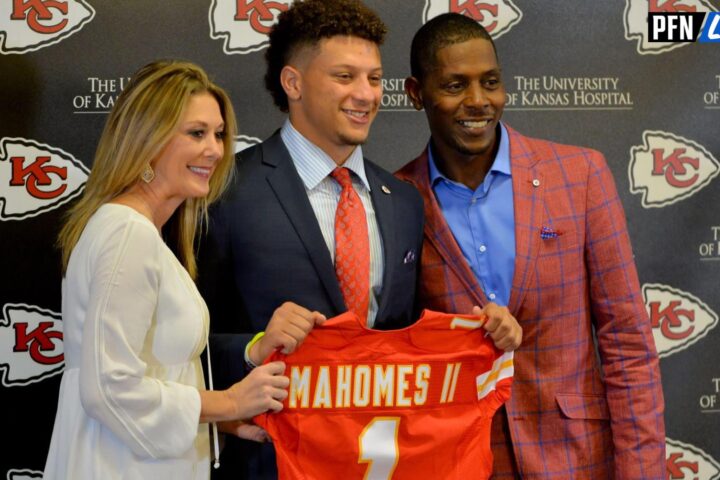The Buffalo Bills‘ RB1 hasn’t been the most valuable of fantasy football assets during the Josh Allen era. Could James Cook change that this year? Should fantasy managers target Cook in 2023 drafts?
James Cook Showed Promise as a Rookie
The last time the Bills had an elite running back was LeSean McCoy in 2017. That year, Shady averaged 16.5 PPR fantasy points per game. The following season, McCoy fell off a cliff. The year after that (2019), the Bills drafted Devin Singletary as their presumptive running back of the future.
As a rookie, Singletary averaged 12.3 ppg. That would prove to be the best year of his career. He spent four years in Buffalo. While the final two weren’t bad, Singletary never did enough to convince the Bills he was the answer at the position.
In 2020, just one year after drafting Singletary on Day 2, the Bills again spent a Day 2 pick on a running back. This time, it was Zack Moss. That experiment quickly failed, and by 2022, the Bills were once again drafting a Day 2 running back.
MORE: FREE Mock Draft Simulator With Trades
As a rookie, James Cook didn’t play much. His snap share was slightly below 25%. He was efficient on his limited touches, though. Cook led all running backs with 12.1% of his carries going for at least 15 yards. He also averaged 6.3 yards per touch, good for third-best in the league.
It’s interesting to try and read into Cook’s rookie-year usage. Over the first 12 weeks, he never so much as reached a 30% snap share in a single game.
In Week 13, Cook seemingly broke out with 105 total yards and 16.5 fantasy points on 45% of the snaps. For the remainder of the season, Cook averaged around a 40% snap share. However, his usage never seemed to get back to Week 13 levels.
Still, the second half of Cook’s rookie season was encouraging. After failing to reach double-digit fantasy points even once over the season’s first 12 weeks, Cook did it three times from Weeks 13-16.
Should You Draft James Cook in Fantasy?
The key to optimism surrounding Cook’s sophomore season is his rookie-year efficiency and the Bills’ moves at the running back position. We already covered the former. As for the latter, the Bills’ offseason moves suggest a belief in Cook taking on an expanded role.
Since 2020, the Bills were mostly rolling out the duo of Singletary and Moss. Well, last season, the Bills traded Moss to the Colts during the year. This offseason, the Bills let Singletary walk in free agency. He has since signed with the Houston Texans. Their biggest move was acquiring Nyheim Hines via trade. But the Bills primarily used Hines on special teams anyway.
Heading into the 2023 campaign, the Bills easily could have spent significant finances or draft capital on the running back position. Instead, their only meaningful move was signing Damien Harris. They didn’t draft a single running back.
This sets up Cook to be in a committee with Harris, which is perfectly fine for fantasy purposes. Seldom few RBs are three-down backs, and Cook was never going to be that guy. We just need Cook to have a solid, fantasy-relevant role. And he does.
MORE: 2023 Dynasty Fantasy Football Profiles
The question, of course, is how much can Cook produce? At 216 pounds, Harris is far more suited for goal-line work. His role should be the early-down grinder and short-yardage back. That leaves the 199-pound Cook as the likely receiving back.
Cook’s usage in the passing game will be the primary source of his fantasy value. It should give him a solid weekly floor, but the lack of touchdown upside caps his ceiling.
There’s also the matter of Josh Allen being a mobile quarterback who not only steals touchdowns but doesn’t throw to running backs that much.
Using Allen’s breakout 2020 season as the starting point, here are his target shares to running backs: 13.5%, 15.4%, and 20.1%. While there’s a clear pattern of increased volume to running backs, 2022 sure looks like the exception, not the rule.
With that said, head coach Sean McDermott has indicated Allen needs to run less and protect himself more if he wants to prolong his career. Perhaps we could see Cook reach something like a 12% target share.
The problem is if you really dive into the numbers, it’s very difficult to be an impactful fantasy asset without touchdowns. For better or worse, touchdowns are everything in fantasy football.
If you’re bored one day and feel like perusing through your old fantasy seasons, take a look at some of your league’s old matchups. Any matchups. You will notice that the team scoring more touchdowns wins an overwhelmingly large amount of the time.
MORE: 2023 NFL Draft Fantasy Football Winners and Losers
Now, that doesn’t mean players who don’t score touchdowns don’t have value. But consider Cook’s likely role. Let’s say he sees 3-4 targets a game while also handling 8-10 carries. What exactly are we expecting overall? Even at an ambitious 5.0 yards per carry, we’re looking at a total of around 60-80 yards, plus a couple of receptions. Even with a solid receptions floor, Cook will have a hard time reaching double-digit fantasy points without scoring.
Meanwhile, Harris can take his 8-10 carries a game, average 3.5 ypc, and surpass Cook’s entire fantasy production by falling into the end zone.
Ultimately, outside of the very rare player who should never be drafted no matter what (i.e. 2022 Kenny Golladay), it all comes down to price. No one is drafting Cook in the third round. Everyone would draft Cook in the 12th round. Where his ADP ends up will determine whether Cook is a worthwhile selection in 2023 fantasy drafts.
As we approach the season, reports will surface on the Bills’ backfield and everyone’s likely roles. Those reports will influence ADPs. It’s still too early to tell where Cook would have to go in order to be a good value. For now, fantasy managers should consider him an upside RB3.




